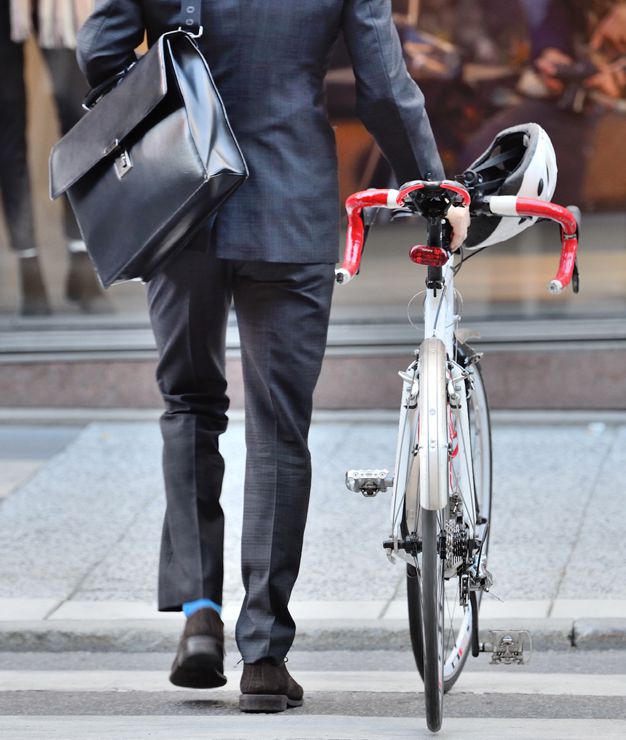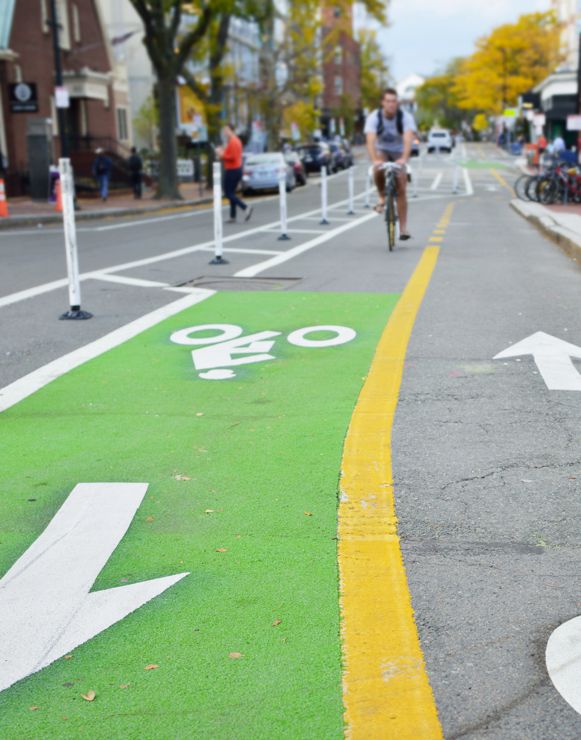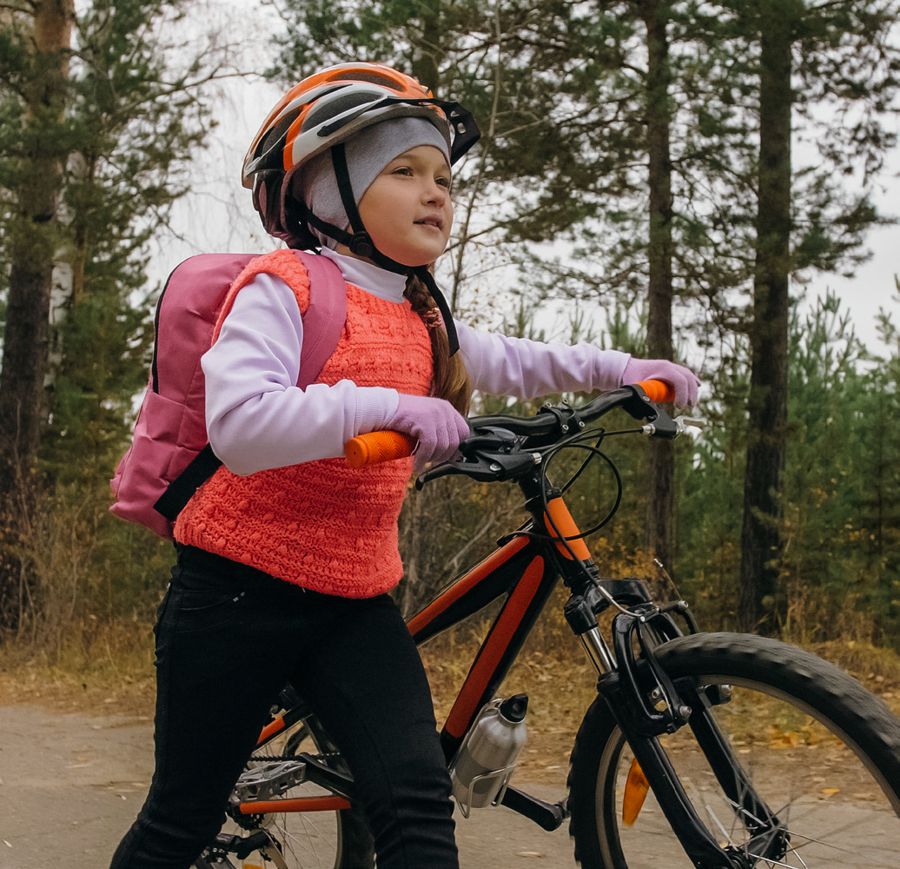According to a 2017 National Household Travel Survey, more than half of all trips in the United States are within a 20-minute bike ride or less from home, and more than one in four trips are within a 20-minute walk or less. And yet, automobiles are still the main mode of transportation for the vast majority of these short trips. But Rails-to-Trails Conservancy (RTC), a nonprofit organization headquartered in Washington, D.C., has a vision of shifting these short trips from driving to walking and biking by creating safe and accessible active transportation networks.
RTC is dedicated to connecting people and communities by creating a nationwide network of public trails—many from former rail lines—"connecting corridors to build healthier places for healthier people." Formed in 1986, RTC is the nation's largest trails organization—boasting a grassroots community more than one million strong. And whether it's in rural, suburban or urban locations, they believe that shifting transportation modes can improve the quality of lives while also creating substantial economic returns.
Walking, biking, rolling or other means of mobility powered by human energy is considered active transportation. RTC's "Active Transportation Transforms America" study recently showed that active transportation infrastructure contributes over $34.1 billion to the U.S. economy each year. The report looked at data related to climate protection, health cost savings, mobility and direct economic value of trails and active transportation. The study also indicated that as infrastructure connectivity improves, the economic contribution could potentially grow to more than $73 billion annually in a modest scenario, and over $138 billion in a substantial scenario. That's almost seven times greater than the $20 billion that federal programs have put toward trails and walking and biking projects over the past three decades.
"These are remarkable economic benefits that we're showing here, and we're not surprised because we see it everyday in our work," said Kevin Mills, RTC's vice president of policy. "But it's really important to have a rigorous methodology to test whether our impressions hold up to the academic scrutiny, and to make the case to decision-makers who might not have thought about it this way. It's one thing to recognize that trails are nice to have, and it's another thing to document the real evidence that they can really be transformative in terms of personal mobility, public health, economic development and the environment."

Mills said the findings of the study are motivating, and prove what they've always known: that connecting trails and walking and biking infrastructure can change communities everywhere for the better. "We have long done economic development studies of the net spending impact of individual rail trails on a local basis, but this is the first time that we've been able to put a national number on that."
According to the report, total local spending impact of the nation's rail-trails is $10.6 billion annually, which could grow to as much as $21 billion annually.
RTC did conduct a similar study back in 2008, and while the numbers were promising, Mills explained that they didn't have the data or methodology to truly understand the economics of trails at a national scale. "Our 2008 report showed that trails and other active transportation infrastructure do have a huge return on investment. But now that we're a decade further out, this report tells us that those methods are really multiplying as we focus on connecting facilities within and between communities. It's that focus on the connectivity—you have a trail here or there and they're of course beloved and wonderful, but when you connect them together and connect people to places they want to go—whether for recreation or utilitarian reasons—those benefits really multiply. That's something that's new that we're seeing in this report."
There are currently more than 2,100 rail-trails spread out over all 50 states. This adds up to more than 24,000 miles of rail-trails, with an additional 8,000-plus miles ready to be built. And another 10,000-plus miles of other types of multi-use trails are part of the greater trail network.
RTC Shares Progress Toward Completing Great American Rail-Trail
By Chandler Garland
Rails-to-Trails Conservancy (RTC) recently revealed that nearly $13 million in funding has been secured for segments of the Great American Rail-Trail across four states. This investment will help close trail gaps and improve existing sections of trail along the 3,700-mile route, which is currently 52% complete. In addition, RTC indicated that nearly 100 miles of new trail along the route are expected to be completed in 2020.
"Since we revealed the route of the Great American in May, there has been an outpouring of enthusiasm for the project," said Ryan Chao, president of RTC. "People are excited about the potential of hiking or biking across the country, and communities are excited about the economic opportunity the project represents. We all know that funding is key to completing the trail, and these early investments give us optimism in the funding and trail miles that will continue to grow."

Rails-to-Trails Conservancy is the nation's largest trails organization—with a grassroots community more than 1 million strong—dedicated to connecting people and communities by creating a nationwide network of public trails, many from former rail lines. Since May 2019, local partners have secured the following funding for trail development along the Great American Rail-Trail:
- BOLIVAR OHIO & ERIE CANAL TOWPATH TRAIL (OHIO): $54,375 from the Timken Foundation of Canton to connect the trail to Bolivar.
- OHIO & ERIE CANAL TOWPATH TRAIL SR 800 EXTENSION (OHIO): $483,000 from the Ohio Department of Transportation to develop trail between Zoarville and Dover.
- NORTH JUDSON ERIE TRAIL EXTENSION (INDIANA): one of the state's Next Level Trails grants for $390,750 to construct 2.1 miles of trail between the eastern terminus of the Erie Trail at U 3 and the town of Ora.
- VETERANS MEMORIAL TRAIL (INDIANA): a Next Level Trails grant for $302,956 to construct 0.9 mile of paved multiuse trail from Tower Crossing to the Lake and Porter county line along US 231.
- ERIE LACKAWANNA TO PENNSY GREENWAY (INDIANA): a Next Level Trails grant for $2,910,172 to complete 2.3 miles of trail between Rohrman Park and Clark Road.
- IOWA RIVER TRAIL, STEAMBOAT ROCK EXTENSION (IOWA): $375,000 in state grant funding to complete 4.4 miles of paved trail between Steamboat Rock and Eldora.
- HEART OF IOWA NATURE TRAIL (IOWA): $530,000 in state funding and $200,000 in regional funding to pave more than 3 miles of the existing crushed-stone Heart of Iowa Nature Trail.
- HIGH TRESTLE TRAIL EXTENSION (IOWA): $403,175 in state grant funding to complete 1 mile of paved trail between Bouton and Woodward.
- TEKOA TRESTLE, PALOUSE TO CASCADES STATE PARK TRAIL (WASHINGTON): $1.7 million in the state's 2019-2021 capital budget to refurbish the trestle over the town of Tekoa and open for trail use.
- BEVERLY BRIDGE, PALOUSE TO CASCADES STATE PARK TRAIL (WASHINGTON): $5.1 million in the state's 2019-2021 capital budget to refurbish the trestle crossing the Columbia River and open for trail use.
Editor's Note: This article first appeared in the RecReport E-Newsletter on Feb. 2, 2020. To sign up to receive the newsletter, visit here.
The signature project of RTC is the Great American Rail-Trail, traversing more than 3,700 miles from Washington, D.C. to Washington State. Encompassing 12 states and the District of Columbia, the trail will directly serve nearly 50 million people within 50 miles of the route. The trail is more than 52% complete, and on the website, RTC President Ryan Chao says the trail will be a national treasure. "It presents a once-in-a-lifetime opportunity to create—together—an enduring gift to the nation that will bring joy for generations to come."
Established in 1983 as an amendment to the National Trails System Act, railbanking is a voluntary agreement between a railroad company and a trail agency to use an out-of-service rail corridor as a trail unit, with the understanding that the railroad might need the corridor again for rail service in the future. This allows the railroad to free itself of unprofitable rail lines by donating, selling or leasing them to private or public agencies for use as a trail.
These are remarkable economic benefits that we're showing here, and we're not surprised because we see it everyday in our work. It's one thing to recognize that trails are nice to have, and it's another thing to document the real evidence that they can really be transformative in terms of personal mobility, public health, economic development and the environment.
— Kevin Mills, RTC's Vice President of Policy

According to Mills, one of their missions is to defend the integrity of the railbanking laws. He described how—back in the 1980s when RTC was founded—communities all over were pointing out that abandoned rail corridors were just collecting trash, etc., and they wondered how the land could be put back into productive use. "Many of our rail-trails have been converted under that law, which is great. It preserves the option of the railroad in the future and it recycles the land as a greenway for the benefit of communities all across the country. It's really a win-win all around."
Health cost savings from increased physical activity due to active transportation is currently $20 billion annually and could grow to nearly $92 billion annually, according to the "Active Transportation Transforms America" report. And looking at environmental benefits, the study shows that the value of fuel savings from shifting short car trips to walking and bicycling trips, as well as accessing public transit through walking and bicycling and reducing congestion is currently $3.3 billion annually, with the potential to reach nearly $22 billion. Additionally, the amount of CO2 saved annually could grow from 13 million tons to 54 million tons annually.
"Transportation emissions are at the top of sources we need to help curb if we're going to bring emissions down," said Mills, stressing that they definitely think trails are part of the solution to CO2 emissions. He described a project they worked on starting in 2005 that was funded by Congress. Four communities were funded and studied from 2006 to 2012, including a rural, suburban and urban community as well as a college town. The idea was to test the theory that if you made strategic investments in connecting up the active transportation facilities in these communities and then promoted them, you could shift driving to walking and biking. "And the project ended up proving that that mode shift does occur. The project calculated that just in those four communities and just in that short time, there were over 85 million miles of driving that were avoided."

Mills believes that the return on investment that trails are showing warrants governments—whether local, state or federal—to start investing more in trail systems. RTC advocates on Capitol Hill and to state legislatures and local governments for investments and policies that support safe trail, walking and bicycling networks for people of every age and ability. And they've seen some positive signs, like the federal USDOT Build Grant program that grew out of the recession a decade ago. The program supports transportation solutions across modes, and Mills said that trail proposals have been receiving a bit more money and attention recently. "We think Congress can help structure the way they do funding better so that it's responsive to the strong demand we're seeing all around the country for getting these trails connected."
Health cost savings from increased physical activity due to active transportation is currently $20 billion annually and could grow to nearly $92 billion annually, according to the "Active Transportation Transforms America" report.
Some innovative states are moving forward with climate change as a driver for their trail plans. Mills pointed out that in California, they're beginning to fund trails as a climate solution, so in 2017 they committed $1 billion of climate policy revenues to their Active Transportation Program. And now they're considering federal potential bond measures that could invest further in trails as part of a climate resilience strategy, which could end up on the ballot next year, according to Mills.
He also mentioned a nine-county region around the Bay Area in California where they're considering putting on the ballot some large investments in trails and active transportation as a mobility and climate measure. "It shows you that a place that invests heavily in state resources for trails as a climate solution is now beginning to look at 'What else can we do,' because it's just so important to act in this regard." Mills added that while a lot of places aren't acting on it yet, it is a trend that we're seeing the beginnings of.

RTC also mobilizes their many trail supporters and the public to advocate in their own communities for safe walking and biking infrastructure. "We've got a strong grassroots community behind us; more than a million people who are dedicated to connecting people and communities through a nationwide network of trails," said Mills, adding that they offer events for volunteers such as their Opening Day for Trails, taking place in 2020 on April 18, which has attracted tens of thousands of volunteers on that day. Since 2013, Opening Day has encouraged people to get outside and celebrate America's exceptional trails and trail systems, whether it's to play, exercise, volunteer, spend time in nature or explore their community.
Mills also mentioned the TrailLink feature on their website, which helps users locate trails in their area or in areas where they may be travelling, with data and trail descriptions. "This has been a very successful social movement. There were very few rail-trails on the ground when we were founded in the 1980s, and now we see these trails crisscrossing the country and being loved and used."
Going forward, Mills said they're really looking at trail connections. "If you've made the investments in all of the trails we do see on the ground today, you're leveraging those investments and getting a lot more out of them if you're thinking about where are the gaps and how can we make sure they connect to each other. Having the trails connect to each other and then connect to other types of active transportation facilities that will take you where the trail can, it's having all of that put together that will really multiply the benefits that we see and that we've documented in this report."
The "Active Transportation Transforms America" report shows that these trail facilities have the potential to provide an impressive return on investment in the form of benefits that:
- Enable more users to connect to their destinations by walking or biking.
- Improve people's health and reduce the cost of health care.
- Reduce greenhouse gases and oil dependence.
- Encourage economic investment in our communities.
RTC believes that "With the same strength of vision that built the railroads and the interstate, America can provide the benefits of safe, connected active transportation networks and spines everywhere, for everyone." RM


